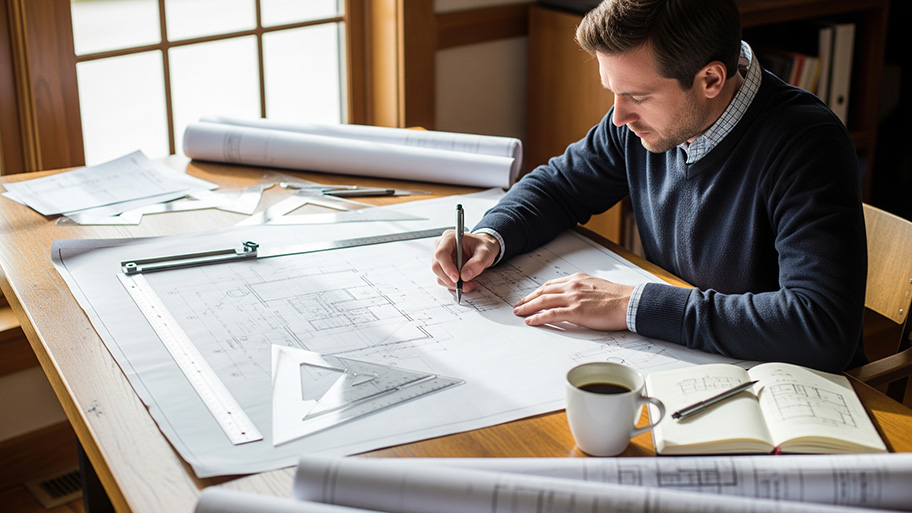
Wondering how much hiring an architect cost? Discover architect prices, cost factors, and money-saving tips to help you plan your home project with confidence.
Your vision is the foundation of a picture-perfect home


After searching high and low for the perfect house on the market, you've realized nothing beats the home you've visualized, doodled, and dreamed of for decades. Learning how to design a house takes a team of sharp minds, including an architect or a home designer. That being said, you will play a key role in determining the details of your dream abode every step of the way. Here's what to expect.
Even if the process feels daunting initially, rest assured that you won't have to go it alone. Figure out who you need to hire to design a house and compile a team that has your back. In this case, you'll have a few options.
Hiring an architect, for example, will transform your home into a custom blueprint. Working with a home designer will help you envision the big picture—from the floor layout to the type of siding. And finally, a construction manager or general contractor will help you compile a team of designers and builders. As you interview a selection of pros, start the design process on your own so that you're prepared when you present your dream structure.
Begin by getting real about the numbers. The cost to build a house typically ranges between $100 and $500 per square foot. On average, you'll spend about $300,000 in total for most builds depending on location, size, and every detail you choose to make your house a home. While your team will help you determine a realistic budget during the design process, it's important to calculate how much you can afford and which type of home loan is best for you.
There's a reason you've chosen to learn how to build your own house, and your must-have list is likely it. Make this list before choosing the plot of land whenever possible. Your list may include the number of bedrooms, bathrooms, and communal living areas.
The list should be specific about your requirements for an outdoor living space, major home systems such as your HVAC, and its relation to major utilities such as a local sewer system. This is also a good time to consider accessibility requirements for you and your family members. Keep this list on hand when initial meeting with your prospective design team.
Now that you have a list of the deal breakers, throw caution to the wind and brainstorm with abandon. Peruse architectural websites, magazines, and pictures of your dream neighborhoods during this phase. While the process may feel generic, use the brainstorm phrase to narrow down the following categories.
Architectural home styles offer a launching-off point for your home designer and architect. Even brand-new homes can emulate the look of a classic Victorian, Craftsman home or a log cabin. Additionally, get to know the other homes in the area where you plan to build to pull inspiration from the look of your block. At this stage, it's important to check in with local HOAs and city building codes to ensure there are no restrictions on home styles.
Consider your ideal floor plan to map out the interior of your home and advise what the exterior will need to accommodate. If you're dreaming of an open floor plan, for example, an architect must know this early on to design a structurally stable home to support wall-free spaces. Take this moment to determine if you want a one-, two-, or even three-story home as well. Make a list of each individual space you would like in your new home, including transitional areas such as foyers and hallways.
Here's where you get to let loose. Have you always wanted a solarium? How about an en-suite bathroom in the primary bedroom? Get as specific as the type of Italian marble on the countertops or the spiral staircase leading up to your guest bedroom. Knowing this list ahead of time can help you and your team decide on the style of each must-have on your list.
Gather all the information from your must-have and nice-to-have lists and write a home design brief for your team. The list will include everything from your ideal home style to the approximate dimensions you'd prefer for each room. Include the individual spaces, the ideal home systems, and even the placement of major appliances. A brief is invaluable when interviewing a design team, though remember that many architects will help you solidify this brief as you begin collaborating.

With the brainstorming behind you and the plot of land secured, it's time to look at some visuals. Work with your design team to determine your home's indoor and outdoor layout. This step goes beyond the floor plan and takes the property into account as well. Here's what to consider.
The land you've purchased should include a comprehensive land survey so you and your builders know the plot details. If not, you must hire a local land surveyor to analyze the area. The survey will determine the slope of the lawn, major natural elements such as trees, and drainage issues.
What size outdoor space would you prefer, and how will you use it? During this stage, your team of designers will help you take the land survey and determine the best placement of patios, play areas, and gardens. The step will also dictate the exterior structure of your home.
You and your designer can work with stock home layouts or customize the house shape with 3-D CAD software. Take each item from your brief and get specific. Determine the square footage of each room, the placement of windows for ample sunlight, and where major structural elements will live, such as the stairways.
With your initial collaboration complete, you and your team will make major decisions so that your draftsperson can draw up blueprints. Blueprints cost an average of $1,800 but keep in mind that custom homes can push the price up to $20,000 for complex projects. Here's what you will determine during this pre-construction phase.
Blueprints will consider the type of foundation necessary for both the land and your home layout. Choosing the type of foundation will allow you to plan for potentially finishing the basement or placing storage space elsewhere in the house.
While construction blueprints do not always include HVAC, plumbing, and wiring, it's essential to consider your ideal options so your home designer can plan for them. These blueprints will come later when you receive electrical drawings and plans for your rough-in plumbing.
You and your team should take this time to confirm local building codes. If you live in a flood, fire, or earthquake-prone area, you may be required to use specific building materials or keep your home to a particular floor plan. Building codes will also clarify your home's distance from local utility lines, easements such as sidewalks, and major natural elements such as bodies of water.

While you will have discussed options during the briefing stage, now's the time to solidify details such as flooring, countertops, exterior siding, and cabinetry. The process will help your contractors source materials within your timeframe and bring in specialists if necessary. For example, installing hardwood floors may affect construction earlier in the process.
You can also take this opportunity to hire an interior designer or an interior decorator. They will help you coordinate furniture placement, paint colors, and even choose fixtures in your bathroom and throughout the house.
Planning a house is a complicated process with many different methods for success. With so many moving parts, homeowners face a few common mistakes when building a house that homeowners face. Here are some tips on how to avoid them.
Don't jeopardize the structural stability and quality for a quicker timeline. The pre-construction process takes at least a month on average, not including the permitting phase.
Survey the land thoroughly for any physical limitations or factors that could affect the building of your house. A rocky terrain, hill, slope, or water source could jeopardize the success of your layout.
If you plan to sell your home in the next decade, consider how some renovations can affect your ROI and how others will not withstand the test of time.
Visualize yourself walking through your new home to see if your layout fits your lifestyle.
Plan for the future. If you know you want to expand your family, consider including additional rooms.
Consider noise when designing bedrooms and living spaces when designing your floor plan.
Research potential tax incentives when choosing home building materials, your HVAC system, and finishes. Energy Star systems and other sustainable options can lower your long-term costs.
Consider the orientation of your home for maximum natural light.
Be flexible as you go—you might need to make many changes along the way.
Designing a home on your own is no easy feat. While you can use software to design a blueprint for a home or find downloadable, ready-made homes, you’ll want to avoid DIYing a project of this magnitude unless you have experience designing homes. That being said, working with a team of enthusiastic architects and home designers will still allow you the freedom to steer the direction of your vision.
Additionally, remember that you have options when hiring a home-building team. If the cost of hiring an architect gives you sticker shock, you may have the option to work directly with a general contractor and stock home plans that cost less than a custom design.
From average costs to expert advice, get all the answers you need to get your job done.

Wondering how much hiring an architect cost? Discover architect prices, cost factors, and money-saving tips to help you plan your home project with confidence.

Few things elevate your outdoor space like a landscape architect can. Learn about how much a landscape architect costs and what affects your total.

Need to know how much blueprints cost for your new construction project? Use this comprehensive cost guide to get an accurate estimate for your build.

You'll encounter many types of architects in your search for the best pro. Keep these specialists in mind before your next renovation or home build.

It’s uncommon for people to have their home’s blueprints sitting in a drawer, but you might need them. If you do, here’s how to get blueprints of your house.

Find out how to hire a land surveyor from the prep stages all the way to signing the contract. Knowing what to look for will help you save time and money.